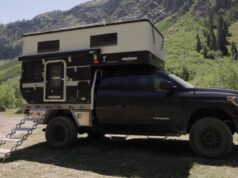Jill and Charles have created a beautiful off-grid yurt homestead in Vermont, on a forested hillside, with solar power, rainwater collection and a rocket mass heater. But this project didn’t come together overnight – it’s the result of over 8 years of planning and working towards this dream of theirs!
source.image: Exploring Alternatives
It all started 8 years ago when they visited Vermont to look at properties and ended up buying a beautiful forested 20 acre piece of land. They went home to Dallas, Texas with a 5-year plan to save up enough money so that they could move onto the land in Vermont and create their off-grid homestead. The plan ended up being extended to 6 years with the purchase of 10 additional acres, but they eventually made it up there!
source.image: Exploring Alternatives
In the 2 years that they’ve been on the property, they lived in an RV at first (that was also off-grid with solar and rainwater), while they built their yurt home. The yurt is a 30-foot Pacific Yurt with modern materials (vinyl cover and reflectix insulation) that provides approximately 700 square feet of living space. They finished it inside with a kitchen and enclosed bathroom, and the rest is all open concept living space for the dining area, bedroom, office, and storage.
Advertisement
The yurt was meant to be a quick and affordable home to set up, but it ended up taking quite a lot longer than anticipated, especially because they had to build a post and beam platform and deck to create a flat area where the yurt could be put up, and install all their own systems for heat, rainwater collection, and solar power.
The cost was a lot more than just the cost of the yurt kit. They also had to factor in some big ticket items like the platform and deck, the SIP floor panels, the appliances, the solar and rainwater collection systems, and more! Now that it’s complete, the couple has a beautiful, cozy, round home in the woods where they can enjoy being immersed in the forest, and get to know their neighbours, the birds, bears, coyotes and bobcats. Their next steps include building a covered entrance to the yurt, and planting fruit trees.












